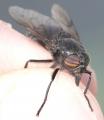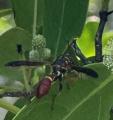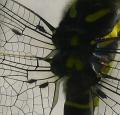Diptera.info :: Identification queries :: Diptera (adults)
Who is here? 1 guest(s)
|
Chloropidae; wing fanning and pheromone sacs
|
|
| nick upton |
Posted on 16-04-2010 15:48
|
|
Member Location: Wiltshire, UK Posts: 828 Joined: 12.03.10 |
Is this tiny yellow fly a Chloropid and is it possible to get anywhere near an ID for it? Wiltshire, southwest UK 16.4.10 nick upton attached the following image:  [92.93Kb] Edited by nick upton on 19-04-2010 18:08 Nick Upton - naturalist and photographer |
|
|
|
| Paul Beuk |
Posted on 16-04-2010 18:54
|
|
Super Administrator Location: Netherlands Posts: 19403 Joined: 11.05.04 |
Most likely Thaumatomyia notata.
Paul - - - - Paul Beuk on https://diptera.info |
| nick upton |
Posted on 18-04-2010 21:36
|
|
Member Location: Wiltshire, UK Posts: 828 Joined: 12.03.10 |
Many thanks Paul. OK, so this is the Yellow swarming fly... notorious for huge gatherings in roof spaces. There are suddenly masses in my garden now it's warmer, so maybe my attic was full of them over the winter. Today some (presumably males) were sitting on leaves, running around and then fanning their wings when another fly passes close by or lands. Some flies (maybe females) fly very slowly close to bushes where males are sitting and occasionally fanning. I took some photos of this, and can see that the flies that fan also evert 5 yellow vesicles form the tip of the abdomen, almost certainly for releasing pheromones. I assume that these are males doing this and maybe the last photo posted below is a female with a fatter abdomen? Or is there a surer way of sexing Chloropidae. It might be a male before it has everted the vesicles and maybe females haven't emerged yet as I haven't seen any mating yet. I thought this might be a new observation but there is at least one study which suggests pheromones are involved in the winter aggregating behaviour as well as courtship. http://www.britannica.com/bps/additionalcontent/18/36877837/Male-flies-with-yellow-balls--New-observations-on-the-eversible-vesicles-on-the-postabdomen-of-male-Thaumatomyia-notata-Diptera-Chloropidae
nick upton attached the following image:  [178.92Kb] Edited by nick upton on 19-04-2010 18:16 Nick Upton - naturalist and photographer |
|
|
|
| nick upton |
Posted on 19-04-2010 18:18
|
|
Member Location: Wiltshire, UK Posts: 828 Joined: 12.03.10 |
Here is a clearer picture of the everted vesicles of a male? in between fanning activity.
nick upton attached the following image: 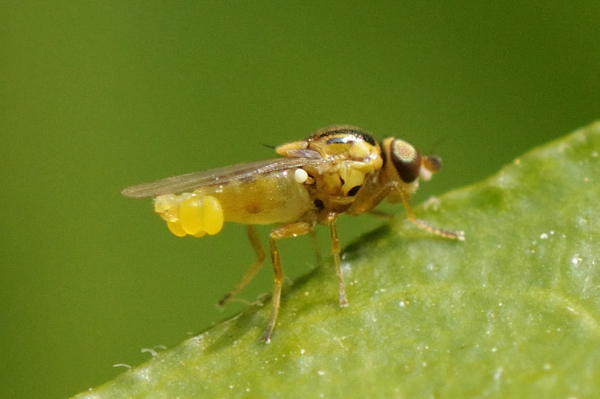 [182.01Kb] Nick Upton - naturalist and photographer |
|
|
|
| nick upton |
Posted on 19-04-2010 18:19
|
|
Member Location: Wiltshire, UK Posts: 828 Joined: 12.03.10 |
And a top view to show the 5 lobes of the everted vesicles.
nick upton attached the following image: 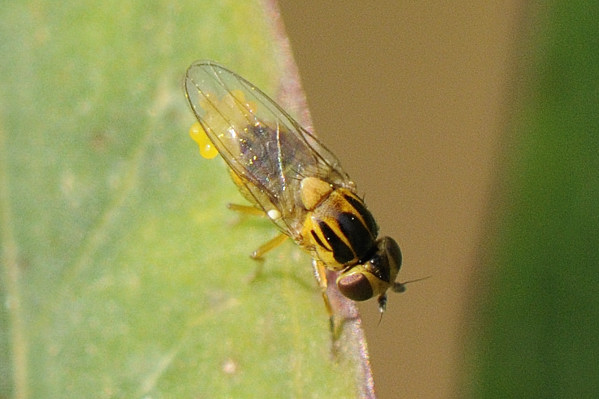 [116.27Kb] Nick Upton - naturalist and photographer |
|
|
|
| nick upton |
Posted on 19-04-2010 18:21
|
|
Member Location: Wiltshire, UK Posts: 828 Joined: 12.03.10 |
And finally, this is a ?? female with maybe a wider abdomen, but it could be male before the vesicles are everted. Does anyone know how to sex Chloropidae visually?
nick upton attached the following image:  [116.04Kb] Nick Upton - naturalist and photographer |
|
|
|
| paqui |
Posted on 19-04-2010 21:45
|
|
Member Location: Valencia (spain) Posts: 816 Joined: 02.09.05 |
Hello, little help (or none at all), I don´t dare translating this (Faune de France is less detailed). Abdomen: *"Afterglied des male groß oder klein (..), hinten senkrecht zur Abdominal-Längsachse abgestutzt und unterseits mit mehr oder weniger (..) sackförmig geschwollenen Backen versehen, die unten in nach vorn oder hinten gerichtete (..) und gekrümmte spitze oder stumpfe Hacken (..) auslafen; Legeröhre desfemale mehrgliedrig, retaktil, oft seitlich komprimiert, dorsal in zwei breite und kurze, oder lange und schmale (..) Afterlamellen auslaufend ..." * "t1 (tibia) und t2 bisweilen innen oder hinten beim male auffällig lang behaart" * "Tarsen meist schlank, nur die vorderen Metatarsen der male mancher Arten auffällig verkürzt" Duda, O., 1933, Chloropidae (Lindner series) :| Good luck :) - I´ve edited male and female icons into the English word Edited by paqui on 19-04-2010 21:50 |
|
|
|
| nick upton |
Posted on 21-04-2010 17:20
|
|
Member Location: Wiltshire, UK Posts: 828 Joined: 12.03.10 |
Thanks Paqui. I speak some German, but this is a little technical and I don't know all these words for sure, but I think it describes the swollen sacs on the male abdomen that my shots show. Nick Nick Upton - naturalist and photographer |
|
|
|
| Jump to Forum: |




